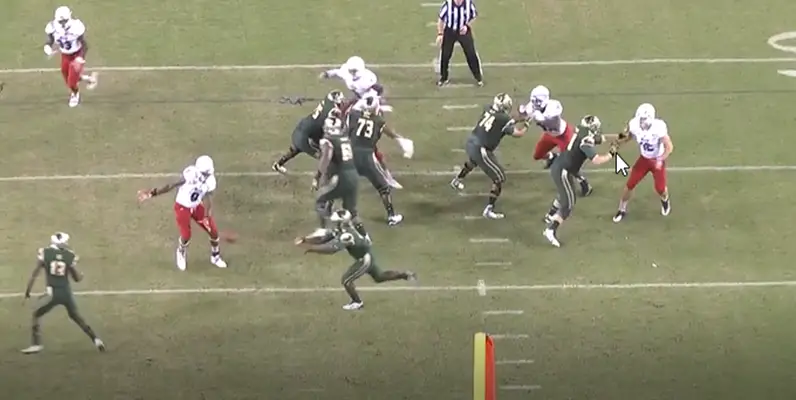A few things became crystal clear to me as I poured over hours of South Florida game footage from this past season. For starters, the offense is just plain cool. It’s a run-first system with a ton of variety and ingenuity to it. This offense is really fun to watch!
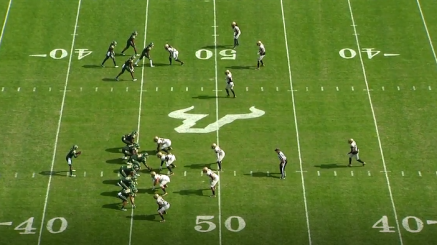
Willie Taggart runs a wide-open, run-heavy spread offense.
It’s been said that while designing his spread offense, Willie Taggart studied Oregon, Auburn, Clemson and Baylor. You can see a little bit of each offense within this one.
Secondly, the offense is not as predictable as some fans had concluded upon the hiring of the new coach. I’m sure we’ve all heard the statement, “This offense isn’t complex enough to keep up with Pac-12 defenses.” After watching the footage, I’m completely confident that this is not the case.
Lastly, Taggart seems to like incorporating the reading of defenders in his run plays. It was awesome to see how much the quarterback was reading defenders in almost every running play.
The Toss Read is a good example of Taggart’s creativity in adding the reading of defenders to a variety of run plays. USF used this play quite successfully against Northern Illinois last season, and the Bulls offense really carved up the NIU defense for 658 yards and 48 points. (This play was a solid contributor to those numbers!) The Toss Read is a quasi-combination of two plays that Oregon had been running under the Kelly/Helfrich regime; the Toss Sweep and the Speed Double Option.
Chip Kelly first started sprinkling the Toss Sweep into the Ducks offense as a counter to the Inside Zone Read (shown above). The Toss Sweep play that Oregon has utilized is a “pin-and-pull” concept, usually having the center and play-side tackle pull, while the rest of the line pinned the back side. The running back would run laterally away from the quarterback, instead of the cross-face motion of a regular Inside/Outside Zone Read handoff, and after receiving the toss, he would read the blocks of the pulling center and tackle and go from there. This is a very basic breakdown of the Toss Sweep.
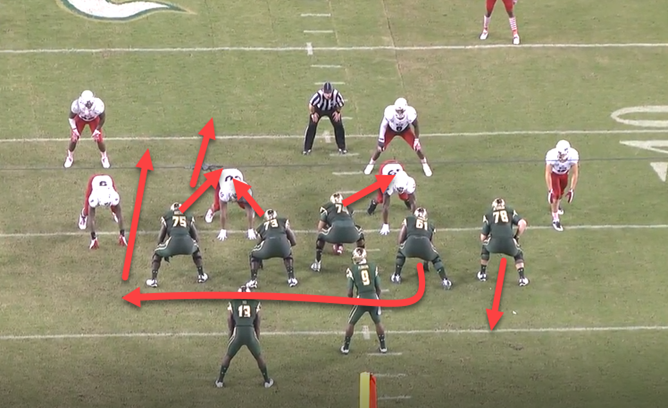
The offensive line runs a power blocking scheme, leaving the play-side defensive end unblocked.
Now, the blocking scheme (above) for Taggart’s Toss Read is pretty simple. At its core it is a power blocking scheme more akin to what you would see in the Inverted Veer (covered in an upcoming article), another read play that Taggart likes to run.
The assignments of the offensive line are illustrated by the red arrows in the visual above. The play-side tackle through the center all down block, unless covered up by a defensive lineman. In this case, the offensive lineman would block whoever is heads up on them. The down-blocking from the tackle, and his eventual sealing of a next-level defender, leaves the play-side defensive end unblocked.
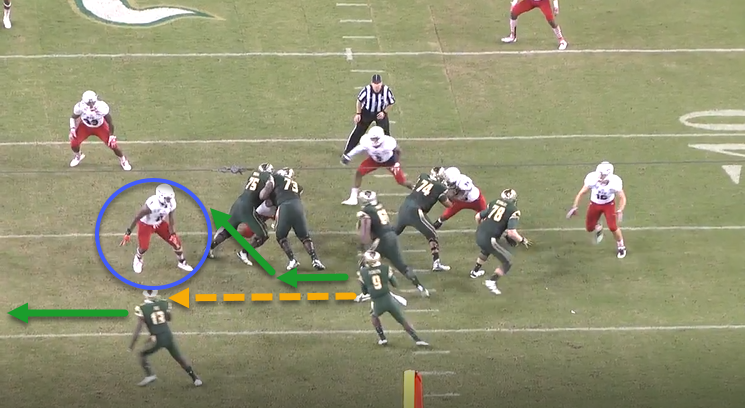
The quarterback reads the play-side defensive end, and decides to toss or keep the ball.
This defensive end (circled in blue, above) will be the defender being read on the play. The back-side guard pulls to the play-side and leads through the alley on the inside of the unblocked defensive end, blocking the first jersey of the opposite color. The back-side tackle (No. 78) will essentially pass protect, keeping any back-side defenders off of the QB.
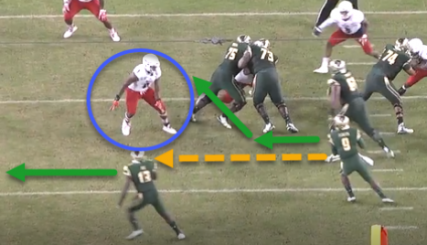
The defensive end has found himself in no-man’s land.
At the snap of the ball, the running back is going to run laterally away from the quarterback (green arrow). Upon receiving the ball, the quarterback will take a shuffle step in the direction of the running back, giving him an extra beat to read the play-side defensive end (blue circle).
If the defensive end crashes down on the quarterback, the ball is tossed to the running back. The back will then read the blocks of the wide receivers and turn it up field. If the end gets wide, the quarterback will fake the toss and keep the ball, following the pulling guard through the alley (green arrow).
In the video above, the defensive end being read crashes down on the quarterback. This prompts the toss option and the running back takes the ball for a 19-yard gain.
In the video above, the defensive end gets wide to stop the running back on the toss. This gives the quarterback the opportunity to keep the ball and follow the pulling guard for a modest 3-yard gain.
Taggart employs this play from a variety of different formations, so there is no real “tell” for the defense to cheat on. My personal favorite is when he runs it from a formation with an H-Back. The H-Back doesn’t aid the offensive line in the blocking of the defensive line but instead hits the perimeter and acts as a lead blocker for the running back. I like the idea of a bigger blocker leading the running back, bulldozing a safety.
While Justin Herbert may not be the burner that Quinton Flowers was for Taggart at USF, he has enough speed and mobility to make this play work. If you’re not someone who believes that Herbert has this thing locked up, Terry Wilson does fit the bill very nicely.
RB “Rolls” Royce Freeman is more than capable of taking the ball out on the perimeter, and if they want even more speed to the outside, RB Tony Brooks-James is the man to do it. If the blocking of the offensive line and wide receivers are up to par (and there’s nothing to suggest that it won’t be), the Toss Read will be just as dangerous for the Ducks as it was for the Bulls.
Since Charles and coach Ruskin just saw Oregon practicing this play on Saturday, it’ll be interesting to see the Ducks running the Toss Read when they play their annual Spring Game on April 29th.
Coach Eric Boles
Newark, Ohio
Top photo from Video
Eric resides in Central Ohio, just outside the capital city of Columbus. He is a former offensive assistant and return game coordinator for the Ohio State – Newark/Central Ohio Technical College Titans football program.
He is an OSU-N graduate, having completed a Bachelor of Arts program in psychology.

